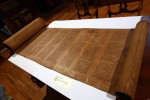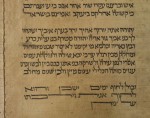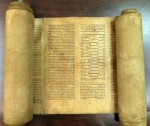 The oldest complete Torah in the world has been discovered in the library of the University of Bologna. Known simply as “Scroll 2,” the sheepskin scroll is 118 feet long and 25 inches wide and had been erroneously dated to the 17th century by librarian Leonello Modona in 1889. Modona was the first to catalog the university’s collection of Hebrew manuscripts. He was himself Jewish and highly educated but he wasn’t a Hebrew scholar so his dating was a guess. It was even accompanied by a question mark.
The oldest complete Torah in the world has been discovered in the library of the University of Bologna. Known simply as “Scroll 2,” the sheepskin scroll is 118 feet long and 25 inches wide and had been erroneously dated to the 17th century by librarian Leonello Modona in 1889. Modona was the first to catalog the university’s collection of Hebrew manuscripts. He was himself Jewish and highly educated but he wasn’t a Hebrew scholar so his dating was a guess. It was even accompanied by a question mark.
The key to cracking the true age and rarity of this Torah was the script. Modona had described it as “an Italian script, rather clumsy-looking, in which certain letters, as well as the usual crowns and strokes show uncommon and strange appendices,” but when Professor Mauro Perani came across the scroll last year while working on a new catalog of the university’s Hebrew manuscript collection, he immediately recognized that the script wasn’t some weird anomalous Italian style, but rather a superb example of a Babylonian script that was in use way earlier than the 17th century. It was in fact a hand more like the 12th or 13th centuries. Perani sent pictures of the scroll to other Hebrew scholars who all concurred with his assessment that the script dated to the 12th or 13th century.
 Another important clue to the great age of this scroll is the presence of line justifications, compressed letters and “crowns” over certain letters prohibited in the rules on Torah copying established by the great 12th century rabbi Maimonides. Maimonides’ rabbinical regulation on how scribes should copy the Torah have been followed religiously, if you’ll pardon the term, for almost 900 years. The scribe who copied Scroll 2 either predated Maimonides (d. 1204) or hadn’t yet heard about the new standard.
Another important clue to the great age of this scroll is the presence of line justifications, compressed letters and “crowns” over certain letters prohibited in the rules on Torah copying established by the great 12th century rabbi Maimonides. Maimonides’ rabbinical regulation on how scribes should copy the Torah have been followed religiously, if you’ll pardon the term, for almost 900 years. The scribe who copied Scroll 2 either predated Maimonides (d. 1204) or hadn’t yet heard about the new standard.
The textual and graphic evidence of age was confirmed by two radiocarbon tests, one performed at the University of Salento and the other by the Radiocarbon Dating Laboratory at the University of Illinois, Urbana-Champaign. The results date the scroll to between 1155 and 1225. This makes it the oldest complete Pentateuch (the first five books of the Bible: Genesis, Exodus, Leviticus, Numbers and Deuteronomy) known to have survived. The previous record-holder dates to the 14th century.
 Torahs this old are such rarities because even if they managed to survive destruction during centuries of pogroms, expulsions and the horrors of World War II, Torahs that are worn or damaged can no longer be used for services because they are deemed to have lost their holiness. When a Torah’s lifetime has run out, it is ritually buried.
Torahs this old are such rarities because even if they managed to survive destruction during centuries of pogroms, expulsions and the horrors of World War II, Torahs that are worn or damaged can no longer be used for services because they are deemed to have lost their holiness. When a Torah’s lifetime has run out, it is ritually buried.
Scroll 2 appears to be in beautiful condition. We don’t know how long it has been curled up in the University of Bologna library, but Perani thinks it’s been centuries. The University began teaching Hebrew classes in the 15th century, but it’s not likely they’ve had it in their possession quite that long. There’s some speculation that it may have been part of a Dominican monastery scriptorium — in the early Middle Ages, Dominican friars were known to sometimes work with Jewish scholars on ancient texts — when it fell victim to Napoleon’s invasion of Italy in 1796. Bologna became part of a French Revolutionary client statelet called the Cispadane Republic, later expanded into the Cisalpine Republic.  They adopted the same constitution of Directory France which came with suppression of monastic orders. Scroll 2 could have been sent to Paris as booty and then brought back to Bologna with other spoils after Napoleon’s final defeat in 1815 and given to the university library.
They adopted the same constitution of Directory France which came with suppression of monastic orders. Scroll 2 could have been sent to Paris as booty and then brought back to Bologna with other spoils after Napoleon’s final defeat in 1815 and given to the university library.
There will be further studies to see if the history of this remarkable Torah can be traced. Meanwhile, the majestic scroll is set to go on display at the university next month. Plans are also in motion to photograph it in high resolution and upload it onto the library website.
Thank you for this post. Your entries contain so much more information and scholarly detail that just can’t be found anywhere else. This entry is a perfect example of your passion for history and fact.
I would like to use this excellent account in our feature on the Jews of the Heart of Italy which happens to have been well timed – it will be in the July edition of Jewish Renaissance magazine (www.jewishrenaissance.org.uk). If that is permissible how should I credit you?
Do you know if the Torah will be permanently on display in the university?
Please respond by email.
Janet Levin
Editor
Blessed is that medieval tanner, who was able to prepare sheepskins like that. – The scroll is ‘118 feet’ long ? Well, that would be pretty close to 36m. Moreover, those in possession of the right equipment can easily figure out that 118 ft = 31.466721 ell, hebr.: ‘Amah'(אמה). If they now take into account that the average sheepskin is 125cm long, with (on average) 25cm offcut, one can say that 36 sheep contributed to this.
Blessed, therefore, are additionally all those, who realize that 36 equals 2 times ’18’. They shall, to sum it all up, twice drink ‘To Life/Le Chaim’. 😀
Just a minor correction: this is the oldest Torah *scroll* known, but the oldest Torah is still the Aleppo Codex (i.e., a Torah in book form), a century or two older. It is, nevertheless, a remarkable and valuable find.
Sorry, slight correction needed: the two oldest Torahs are the Leningrad and Aleppo codexes, approximately the same age (around 1000 AD); the Aleppo codex is older than Leningrad but lost its Torah section around 1947. Leningrad, despite its name, was written in Cairo.
Wonderful account of the Torah scroll. It is good that the first librarian placed a question mark in the catalogue = 9 out of 10 other librarian would just leave the entry as “fact” and thus leading future people down the wrong road.
Early Irish genealogist used to give two sources if the layouts of a family pedigree was in doubt.
Lovely work – well done.